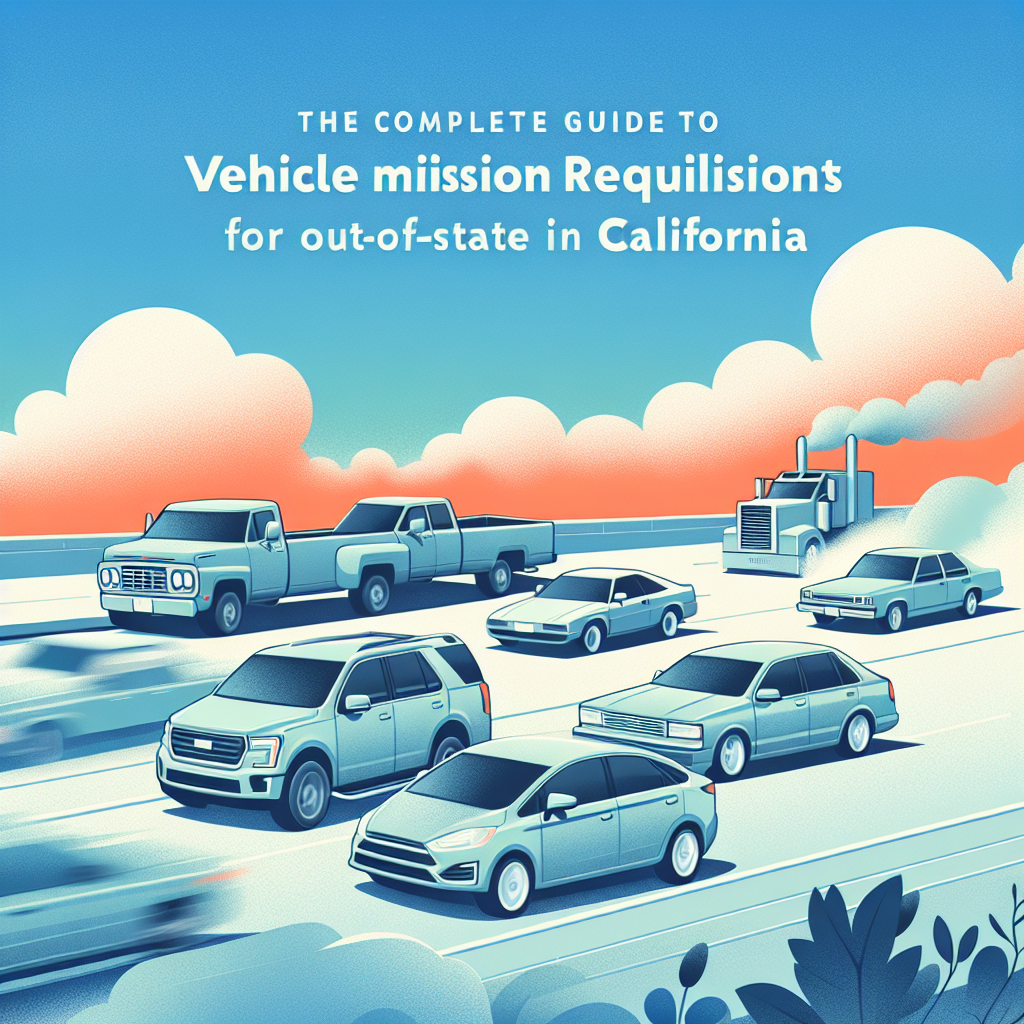The Complete Guide to Vehicle Emission Requirements for Out-of-State Cars in California
Introduction
California is famous for its strict vehicle emission rules to help reduce air pollution and protect the environment. If you’re moving to California or plan to bring a car from another state, knowing the emission requirements is really important to avoid any problems. This guide is here to help you, making sure your car follows the rules so you can drive without any issues.
Overview of California Emission Standards
California’s emission standards for cars are some of the strictest in the United States. They even go beyond the federal rules. These standards are meant to keep the air clean and are managed by the California Air Resources Board (CARB). CARB is in charge of making sure cars meet these standards so they can be legally driven in California.
How to Check If Your Out-of-State Car Complies with Emissions
Before you bring your car into California, you need to make sure it meets the state’s emission rules. Here’s how:
- Check the Vehicle Emissions Control Information (VECI) Label: This label is usually in the engine compartment. It will tell you if the car meets California’s emission standards.
- Use Online Resources and Tools: CARB’s website has tools to check if your car is compliant. You’ll need to enter your car’s make, model, and year.
- Contact the Manufacturer: Sometimes, it’s helpful to ask the car manufacturer for more information about compliance or any changes you need to make.
Steps to Bring an Out-of-State Car to California
Planning ahead can help you bring your out-of-state car to California smoothly. Here’s what you should do:
- Research First: Make sure your car complies with California emission standards before moving.
- Get Necessary Documents: Have your car’s title, registration, VECI label, and any emission compliance certificates ready.
- Vehicle Inspection: Get your car inspected for compliance, especially if it doesn’t have a California-compliant label.
- Pass an Emission Test: Your car needs to pass a smog check to meet state emission rules.
- Register Your Car: Once your car complies, register it in California. This means giving the required documents and paying the fees.
Smog Check Requirements
In California, most cars need a smog check to make sure they meet emission rules. Here’s what you should know:
- Who Needs a Smog Check: Gasoline cars older than six years and diesel cars from 1998 or newer with a GVWR under 14,000 pounds usually need smog checks twice a year.
- Exemptions: Some cars, like all-electric cars, hybrids, and ones that are less than six years old, might not need smog checks.
- Testing Locations: Use the CARB website to find certified smog check stations near you.
What to Do If Your Car Doesn’t Meet Standards
If your car doesn’t meet California standards, you might need to make some changes:
- What Changes Might Be Needed: You might need to change parts like the catalytic converter, exhaust system, or onboard diagnostics.
- Older Cars: Older cars might have a harder time meeting standards but might qualify for certain exemptions.
- Costs and Help: Making these updates can be costly. It’s a good idea to talk to a certified mechanic who knows California rules.
How to Register Your Out-of-State Vehicle
To register your out-of-state vehicle, follow these steps:
- Pass the Emission Test: Make sure your car meets all requirements and has the right paperwork.
- Visit the California DMV: Take all your papers, including emission test results, and pay the fees.
- Get Your California Plates: Once registered, you’ll get new plates, showing your car is compliant.
Common Problems and Solutions
Many people face challenges when registering their car in California:
- Incomplete Paperwork: Make sure you have all your documents ready.
- Delays in Testing or Modifications: Plan your tests and modifications early to avoid delays.
- Get Help from CARB and DMV: Contact these agencies if you need help with compliance issues.
Costs and Fees for Compliance
Knowing the costs can help you plan:
- Testing and Modifications: The cost of smog checks and any changes needed depend on your car’s condition and age.
- Registration Fees: You’ll pay standard fees, plus extra charges if there are compliance issues or late registration.
- Financial Help: Some programs offer help to low-income individuals needing modifications.
Conclusion
Meeting California’s vehicle emission standards is important to ensure a smooth move as an out-of-state driver. With the right planning and resources, your vehicle can comply with the rules, helping to keep the air clean.
Additional Resources
FAQs
Q: Can a vehicle be registered in California without a smog check?
A: Usually, no. Most cars must pass a smog check to be registered.
Q: What if my out-of-state car fails the smog check?
A: You’ll need to fix it to meet the rules, then retest.
Q: How soon must I register my vehicle after moving to California?
A: You need to register it within 20 days after moving here.
Q: Are there penalties for late registration?
A: Yes, not registering on time can lead to penalties and fees.
Q: Can I drive my out-of-state car in California while waiting for compliance modifications?
A: You can drive it temporarily if it’s still registered in your original state, but start compliance soon.
Call to Action
For easy vehicle registration and emission compliance in California, visit Tags Clinic. It’s your go-to solution for a hassle-free experience! We’re conveniently located at 3845 University Ave, San Diego, CA or you can call us at 619-777-9046. We’re looking forward to helping you with all your emission and registration needs!
